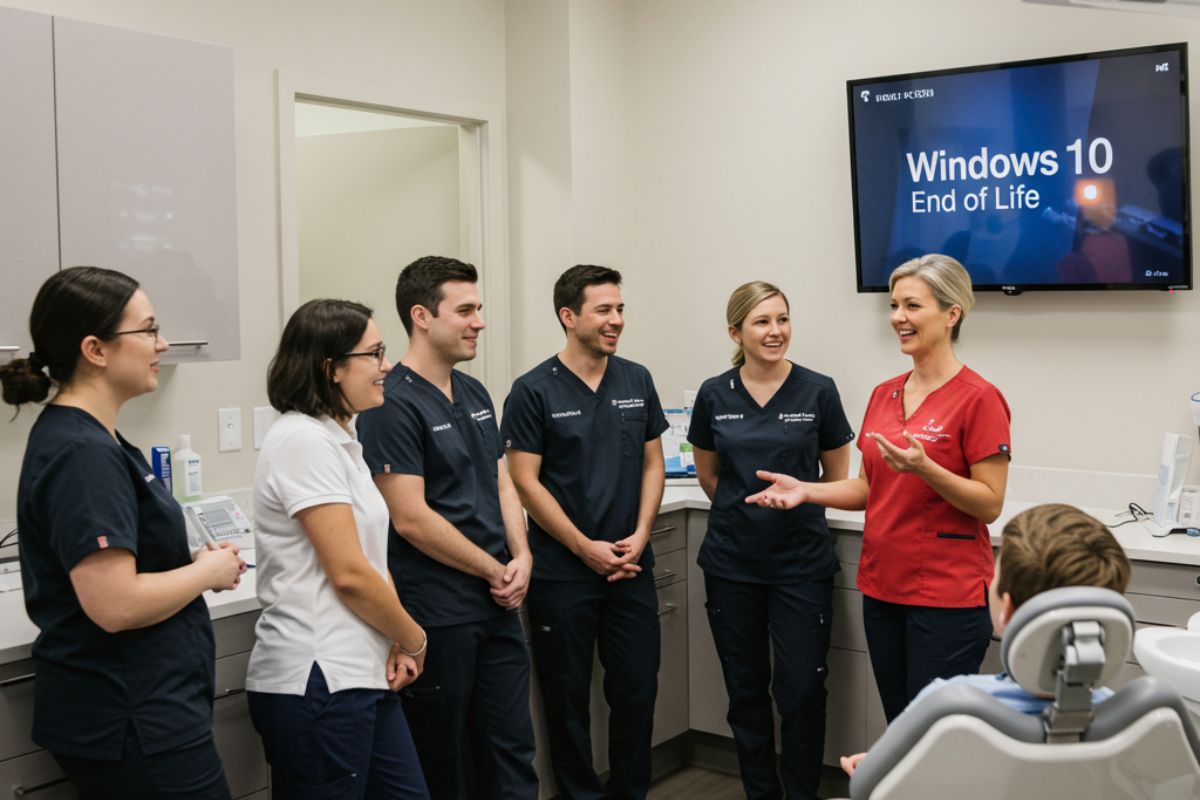August 6, 2025

With Microsoft announcing the end of life (EOL) for Windows 10, dental clinics need to understand what this change entails and why it demands immediate attention. EOL signifies that Microsoft will cease to deliver crucial security updates, bug fixes, and technical support for the operating system. For dental practices, where patient data confidentiality and uninterrupted operations are paramount, the implications go beyond mere inconvenience.
Without ongoing updates, Windows 10 devices become susceptible to newly discovered vulnerabilities, making them attractive targets for malicious actors. Additionally, most dental software vendors align their products with supported operating systems, which means outdated Windows 10 systems may soon be incompatible with essential dental applications, imaging systems, or practice management tools.
For dental professionals in Alberta, British Columbia, and Saskatchewan, remaining compliant with data protection regulations and maintaining the highest standards of patient care hinges on robust, up-to-date IT systems. The end of Windows 10 support is not just a technical milestone—it’s a pivotal moment for clinics to reassess their IT infrastructure and prioritize security, reliability, and compliance moving forward.
As Windows 10 support phases out, dental clinics face a spectrum of risks that could significantly impact their practice. First and foremost, unsupported operating systems quickly become a favorite target for cybercriminals. Without security patches, exploits and malware can infiltrate networks, threatening the privacy of sensitive patient records.
Compliance is another critical concern. In Canada, dental clinics must adhere to stringent data protection laws like PIPEDA and, in some provinces, PHIPA. Operating on unsupported software may put clinics out of compliance, resulting in legal liabilities, fines, and mandatory reporting of breaches. This not only affects a clinic’s finances but also undermines patient trust.
Operationally, as dental software vendors update their products, they may cease supporting Windows 10, leading to compatibility issues with practice management systems, digital radiography, and other vital equipment. This could result in workflow disruptions, increased downtime, and even loss of access to important patient information. The costs of recovering from data breaches, ransom payments, or reconfiguring systems post-attack can far exceed the investment required for proactive upgrades.
Ultimately, clinics that delay upgrading risk both their reputation and their ability to provide seamless patient care, making it essential to act before Windows 10 reaches its end of life.
Once Windows 10 reaches its end of life, cyber security risks escalate sharply for dental clinics. Unsupported systems no longer receive patches for newly discovered vulnerabilities, leaving critical gaps in your network defenses. This is particularly concerning given the increasing sophistication of cyber threats aimed at healthcare providers, which often involve ransomware attacks targeting sensitive patient information.
To safeguard dental records—which are highly sought after on the black market—clinics must prioritize up-to-date antivirus solutions, regularly updated firewalls, and advanced threat detection tools. Backup solutions become even more crucial; frequent, encrypted backups stored securely (ideally off-site or in the cloud) offer a lifeline in case of an attack or data loss.
Canadian regulatory frameworks such as PIPEDA mandate that clinics take all reasonable steps to protect patient data. Operating on an unsupported operating system could be interpreted as a failure to uphold this duty, potentially resulting in penalties and mandatory disclosure of security incidents.
Regular IT audits and vulnerability assessments are essential to identify and address emerging threats. By maintaining a proactive stance on cyber security, clinics not only comply with regulations but also foster trust among patients, who expect their private health data to be diligently protected at every turn.
With the end of Windows 10 support approaching, dental clinics must act decisively to upgrade their IT environments. The first step is a comprehensive assessment of all hardware and software to identify which systems rely on Windows 10. This inventory process helps determine which devices need upgrading or replacement and which applications might need updates or reconfiguration.
Migrating to a supported operating system—such as Windows 11 or an enterprise-grade alternative—should be done with careful planning to ensure compatibility with critical dental applications and hardware. Partnering with IT professionals who specialize in dental clinic environments can streamline this process, ensuring minimal disruption to day-to-day operations.
Equally important is reviewing your backup solutions. Implementing automated, secure, and regularly tested backups—preferably with encrypted off-site or cloud storage—provides a safety net against both cyber incidents and accidental data loss. This is a cornerstone of any comprehensive dental IT strategy.
Finally, staff training is key. Ensuring all team members understand the new systems, security protocols, and backup processes reduces human error and enhances overall cyber resilience. By taking these proactive steps, dental clinics can transition smoothly away from Windows 10, safeguarding both their data and their reputation.
As dental clinics navigate the transition away from Windows 10, the need for reliable, ongoing IT support becomes more critical than ever. Managed IT services provide clinics with proactive monitoring, ensuring threats are detected and addressed before they can cause harm. This approach minimizes downtime and keeps patient care running smoothly, even as the technology landscape evolves.
Regular updates, security patches, and compliance checks form the backbone of a resilient IT environment. Managed services also offer scalability—allowing clinics to expand their IT infrastructure as their needs grow, without the risk of outpacing their security or support capabilities.
Equally important is the cultivation of a security-aware culture. Ongoing staff training in best practices and emerging cyber threats empowers every team member to play a role in safeguarding patient data. This holistic approach—combining advanced technology, proactive services, and knowledgeable staff—creates a robust defense against both current and future IT challenges.
By embracing comprehensive managed IT services and fostering a culture of vigilance, dental clinics can confidently move beyond Windows 10, ensuring their operations remain secure, compliant, and ready to meet the demands of modern healthcare.